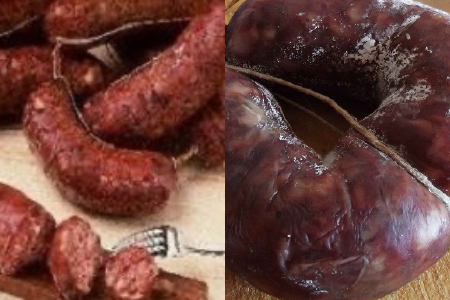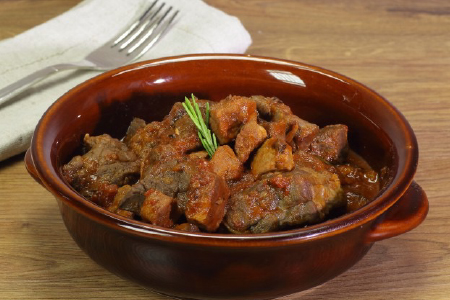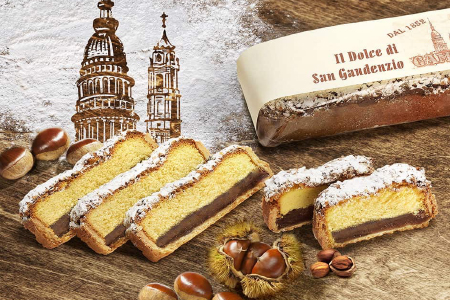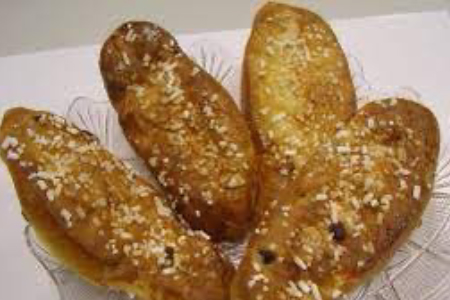
SALAM D’LA DUJA
The salam d'la duja (also written, according to the classic Piedmontese spelling "salam d'la doja" is a pure pork salami preserved in fat. The word "duja" in Piedmontese means "vase, container, container, jar" . Therefore the name of this salami, translated into Italian, would be "salame del vaso", from the glazed earthenware container that is used to preserve the salami in fat. The very unusual method of preserving salam d'la duja is is developed in the very humid plains of eastern Piedmont, where the classic technique of seasoning and preserving salami by air drying in a cool and ventilated environment and at a constant temperature (in the cellars) is not possible due to the high environmental humidity and unsuitable climatic conditions, as they favored the growth of molds.The result of this seasoning and preservation technique in fat was the creation of a new type of salami, which, isolated from the external environment, almost unaltered the softness of the meat that it had at the time of its creation, while accentuating the flavors of the spices that had been added to it, with an accentuation of the spicy flavor. The ingredients to create the salam d'la duja are: lean and fatty pork meats (shoulders, bacon, lard, thigh, culatello, coppa, minced meat), salt, pepper, garlic, spices and wine (generally red and Barbera ). The result of the dough is a little more tender than normal salami. The length of the salami is 15-20 cm, the diameter of 4-5 cm and the size is about 200 grams. When cut, the salami d'la duja have a medium grain with a distinction between the lean part of a dark brick red color and the fat part of a white color.
The salam d'la duja is eaten raw, cut into rather thick slices. The salam d'la duja is one of the ingredients of panissa and paniscia, typical risottos, respectively, from Vercelli and Novara.
Processing methods: The first choice pork and bacon fat are ground to medium grain, seasoned with spices and stuffed into natural twisted beef casing. The salamis are then left to dry for about 2-3 weeks in seasoning cells. In the past, however, salami were dried for about 30 days in cellars with braziers. The dried salami are then placed in an earthenware container (la duja), inside which they are covered with melted pork lard, which, solidifying, preserves the salamis and keeps them soft for long periods, even more than a year, regardless of external environmental conditions. The salami must remain in the duja, under lard, for a minimum of eight to nine months. After the minimum seasoning, the salami can be extracted from the duja whenever you want.
Production area: Novarese, Vercellese, Biellese, but also widespread in other areas of Piedmont and in Lomellina.
(SOURCE www.areeprotettepotorinese.it)

GORGONZOLA
Gorgonzola is a very ancient cheese, some say that Gorgonzola was made for the first time, in the locality of the same name on the outskirts of Milan, in the year of grace 879.
According to others, the birth took place in Pasturo in Valsassina, a great dairy center for centuries, thanks to the presence of those excellent natural caves whose average temperature is constant between 6 ° C and 12 ° C and therefore allows the perfect success of the Gorgonzola, as well as various other cheeses.
The town Gorgonzola, in any case, remains the center of greatest fame, if not of greatest production or trade for several centuries; in fact the first real name of Gorgonzola was that of “stracchino di Gorgonzola”, better defined later by its synonym of “green stracchino”. In this context, it is beyond doubt that its production took place with the autumn milkings of the transhumance returning from the malghe or pastures.
The spread of Gorgonzola, although slow if compared to the successes of other cheeses, was nevertheless constant at least as regards the area between Lombardy and Piedmont: both Pavese and Novarese are massively added to Milan and Comasco in the production of Gorgonzola.
Thus, what the decrees of 1955 and 1977 will define as the area of production and maturation of this cheese, which has now risen to the protected designation of origin, is thus foreshadowed.
From the early 1900s onwards, Gorgonzola tasted its growing successes especially abroad, setting a record in exports with over 100,000 quintals of cheese per year destined for England, France and Germany; while the first country prefers the white Gorgonzola with a mild and slightly spicy flavor, the French and Germans expressly request the one with a veined paste and a marked taste, the so-called “two-paste” Gorgonzola.
Immediately after the war, a new technique was developed, namely the processing of Gorgonzola into "a paste". It gradually replaces the previous production, very empirical, significantly more expensive, hygienically and qualitatively inconstant. The dairies and the many dairies scattered throughout the Po Valley collect the milk from all the farms and produce the cheese which is then transported to the large maturing centers. In the seventies, the more than 100 dairies necessarily had to modernize their production facilities and several small producers, unable to bear the costs, had to leave. There are therefore about thirty well-structured companies that, in addition to processing the milk, mature the Gorgonzola in their modern facilities; they are divided into large and medium complexes.
The production of recent years confirms the shift of the production axis. Among the three major producing provinces, Novara collects over 65%, Pavia 15% and Milan 8%. The rest is divided between the other provinces of the typical production and maturing area indicated by the denomination protection laws.
(SOURCE www.gorgonzola.com)

FIDIGHINA & FIDIGHIN
The "Salame della Duja" ("salam d'la duja" in Piedmontese) is a typical sausage from Novara which takes its name from the container, the duja, in which it is left to mature.
First choice pork (shoulder, thigh, coppa and culatello) are ground to medium grain, together with bacon fat, and seasoned with salt, pepper, garlic and red wine. The salami, stuffed into beef gut, is matured in the duja, covered with melted lard which allows it to remain soft for a long time. This conservation methodology was used in the past especially in the very humid areas of Piedmont, where it was not possible to season salami in the air with the traditional method.
The maturation is followed by maturation lasting eight months / one year.
The “Fidighin” (raw liver mortadella) is another sausage typical of the Novara area, made with lean pork, chin and bacon fat, liver and spices. The quantity of liver determines the color of the salami, more or less red and also the flavor, more or less spicy.
The constituents are ground to medium grain and tanned using salt, pepper, both whole and ground, red wine (Barbera), mulled wine or Marsala, sugar, lemon peel, cinnamon, nutmeg, cloves. After drying for a few days, the product is left to mature for 4-5 months. Fidighin should be consumed exclusively raw.
(SOURCE "NOVARA 900" FACEBOOK PAGE)

PANISCIA NOVARESE
Paniscia alla Novarese is a recipe that has its roots in the past, when our grandparents used the poor ingredients available to refuel with a hot and nutritious meal. It is a very special risotto enriched with typical local products, such as salam d’la duja, a typical sausage from this area of Piedmont that is covered with lard and stored in glass jars. Another feature of paniscia is the broth with which the rice is cooked, which is made with pork rinds, beans and cabbage scraps ... because at the table, you know, nothing is thrown away! And finally the lard, a must in peasant cuisine. A robust and substantial dish, in short, made to fill the belly and lift the spirit! Let yourself be pampered by the flavors of the past and accompany the Novarese paniscia with a good glass of red wine.
(SOURCE YELLOW ZAFFERANO)

RUSTIDA
La Rustida is a typical recipe of the Novara gastronomic tradition, in particular of the Oleggio area.
It is a second course based on meat; once it was cooked when the pig was killed and, just to avoid any waste, offal was also used.
"
(SOURCE WWW.NOVARATODAY.IT)

TAPULONE (OF BORGOMANERO)
Tapulone is an ancient dish of the upper Piedmontese tradition. It is served finely chopped and with plenty of local red wine.
The name is both curious and vaguely evocative, it sounds like a mythological animal, or almost. But the tapulone (or tapulòn) is a name that has nothing feral about it. Indeed, it derives from a local variant of the Piedmontese verb ciapulè which means “to chop, to finely slice, to shred”.
It is an ancient dish of the high Piedmontese tradition, a meat recipe (the Orthodox version wants a particular meat: donkey) in a stew version: finely chopped and served with bay leaf, rosemary, cloves, salt and red wine from the local hills.
Tapulone, the history of the dish
Popular cuisine is an always interesting jumble of stories and narratives. The treadmill makes no difference. Legend has it that thirteen hungry pilgrims, returning from a visit to the sanctuary of San Giulio d’Orta, stopped, exhausted, in search of food supplies after having finished theirs.
Finding nothing edible, they were forced to cook a donkey from their entourage and, to mitigate the hardness of the meat, they began to chop it finely and cook it for a long time in wine.
The meal was so popular that the pilgrims decided to stop and take root right where they ate it for the first time. And so they founded a village, the current Borgomanero.
If nothing is thrown away from the pig, as the adage has it, it could be said that not even a service is thrown away from the donkey. The animal was used as a means of transport and, when too old to bear heavy loads, as a direct food source.
Like all popular recipes, the tapulone also teaches to work with residuality and with simple but effective resources.
(SOURCE VILLACRESPI.IT)

SAN GAUDENZIO'S BREAD
The bread of San Gaudenzio is a plumcake that looks like a panettone, dedicated to the patron saint of the city of Novara, which occurs on January 22nd. This dessert - consisting of a shortcrust pastry shell filled with raisin sponge cake - has been produced and sold in the main pastry shops in the city for more than 40 years and has become one of its gastronomic symbols, together with the famous Novara biscuits produced by the biscuit factory. Camporelli.
San Gaudenzio was the first bishop of Novara and the homonymous basilica is dedicated to him, famous throughout Piedmont for its dome, the work of Antonelli, the architect who also created the Mole, symbol of Turin.
Legend has it that the bread of San Gaudenzio was invented in the seventies by a group of bakers from Novara, but, according to some, this dessert has another origin: on the first Sunday of Easter the religious of the basilica used to distribute to the poor another typical bread, the "chicken bread", made with wheat. When Napoleon closed the convents in the nineteenth century, the nuns who previously lived in them found hospitality with wealthy families and thus made known the recipe for Novara biscuits. In a short time, the bread and biscuits always made a steady couple and who knows that Easter bread was not the ancestor of the typical dessert of the city.
(SOURCE DISSAPORE.COM)

NOVARA COOKIES
This product has a history that dates back to a few centuries ago but, despite extensive research, however, it has not been possible to establish with certainty where and how the famous Novara biscuit originated. However, the first news of the biscuits arrives from the female monasteries of the sixteenth century. In those places, in fact, there were pastry shops where delicacies were prepared for moneyed foreigners in transit. Precisely in these monasteries, quite numerous before the passage of Napoleon Bonaparte, some nuns would have invented the recipe for "that biscuit that would have given fame to the Novara capital".
In those times, it was customary (and lasted until the Great War), that on the first Sunday of Easter, distributions to the poor of a wheat bread called "Pane di Polla" (woman's name or word to be considered derived from the Latin "pollen", meaning fine flour.
With the affirmation of custom, the dessert was called "biscuit of the nuns of Novara" and remained so until the suppression of the convents, wanted by Napoleon, in 1800.
The nuns were forced to change their lives and many found a welcome in the wealthy families of the city, where they transferred and spread their culinary knowledge. From that moment on, the secret of the biscuit packaging fell out and the product was soon put on the market by a pharmacist-grocer, a certain Prina, who began selling it in his shop with his own name: "Biscottino di Novara del Prina".
In short, a free and intense competition was created around the product between the pastry chefs who perfected the biscuit, especially in the cooking technique, so as to improve its storage capacity and to open, as a logical consequence, the possibility of shipping far from Novara. .
When we talk about the history of Novara biscuits, however, we cannot overlook the history of the Novara carnival and the Mask of “King Biscottino”; it runs parallel and brings to the ground the symbolic values that this product has assumed.
In the last century, the expansion of industry called in workers from neighboring countries, immigration increased the city population and started the related problems of integration and assimilation. Just at that time, a "committee" made up of traders, professionals and members of the nobility, took the initiative to give life to a renewed carnival. The aim was obviously to give vent to the climate of euphoria that had been created due to social changes and which made Novara a modern city.
But this carnival was also designed to celebrate the new course of the Novara economy, to honor and advertise its protagonists: the "offalieri" or pastry chefs. In this sense we understand the choice of the new mask: King Biscottino.
The biscuit is thus crowned "symbol of the city" and remains so to this day.
(SOURCE SAPORIDELPIEMONTE.NET)

GALLIATE'S GRAMOLLINI
They are the typical desserts of Galliate, prepared with sugar, flour, butter, raisins, polished with eggs and covered with fine grains of sugar.
The tasty sweets were prepared in the past only for the feast of St. Joseph, March 19, but today they are packaged by artisan pastry shops throughout the year.
(SOURCE TURISMONOVARA.IT)



